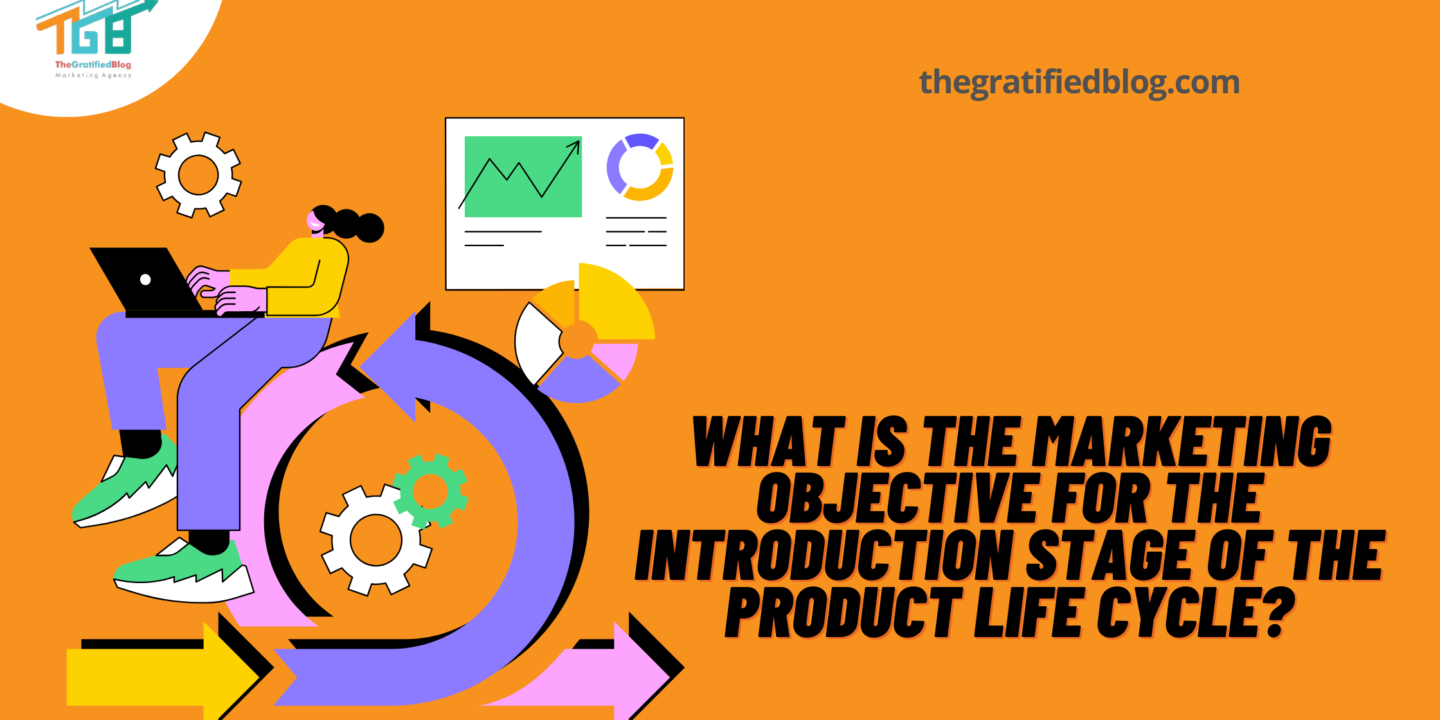
The concept of the product life cycle is fundamental in marketing, indicating that it helps businesses understand and manage the trajectory of a product from its inception to its eventual decline. “What is the marketing objective for the introduction stage of the product life cycle?” is a crucial question during this initial phase. This cycle is typically divided into four stages: Introduction, growth, maturity, and decline. Every stage offers distinct challenges and opportunities, and businesses must tailor their stage-specific marketing strategy accordingly.
In this article, we will see The marketing goal during the introduction phase of the product life cycle And explore the key marketing objectives during this critical phase.
Understanding The Product Life Cycle
The Product Life Cycle is a concept that delineates a product’s phases, from its introduction to its eventual decline in the market. It comprises four key stages: introduction, growth, maturity, and decline.
During the introduction phase, a product is launched into the market, often with high costs and limited sales. Effective product life cycle marketing strategies for this initial stage are essential to create a solid market presence.
The growth phase sees increasing consumer demand, sales, and profitability as the product gains popularity. In the maturity phase, sales stabilize, and competition intensifies.
Businesses employ various product life cycle marketing strategies to maintain their market share and extend the product’s life in this phase.
The product enters the decline phase as consumer interest wanes, leading to reduced sales and profits.
Businesses use this concept to make strategic marketing, pricing, and product development decisions. They adapt their approach to each stage to maximize success and longevity in the marketplace.
Before delving into the specific marketing objectives of the introduction stage, let’s first establish a clear understanding of the product life cycle as a whole.
Introduction Stage
This is the phase when a new product is launched into the market. During this stage, sales are typically low, and companies are focused on creating awareness, gaining initial market traction, and educating customers about the product’s features and benefits.
As the product’s acceptance and demand increase, it moves into the Growth Stage. Here, sales overgrow, and competition intensifies, prompting companies to expand marketing efforts and refine the product.
Subsequently, the product enters the Maturity Stage, characterized by stabilized sales and price competition. In the Decline Stage, sales diminish, and companies may discontinue or revamp the product to extend its life cycle.
Growth Stage
The Growth Stage of the product life cycle marks a period of increasing sales and profitability as the product garners recognition and acceptance in the market. During this phase, businesses focus on expanding their market share, building brand loyalty, and staying ahead of emerging competition.
Marketing efforts are geared towards harnessing the product’s momentum and sustaining its growth. A rapid increase in customer adoption characterizes this stage, and companies often invest in product improvements and innovation to maintain their competitive edge.
It’s a critical phase for maximizing profitability and solidifying the product’s position in the market.
Maturity Stage:
In the maturity stage of the product life cycle, sales reach a plateau, and competition becomes more intense as multiple players vie for market share.
The primary marketing objective during this phase is to sustain market share while effectively managing costs. Businesses may also focus on extending the product’s life by introducing innovations, updates, or product variations to retain customer interest.
Slower sales growth, price wars, and a greater emphasis on customer retention and brand loyalty characterize this stage. Strategic adaptability and continuous improvement are essential to navigate this phase successfully.
Decline Stage
In the Decline Stage, products face a natural progression as market saturation, evolving customer tastes, or technological innovations diminish their appeal.
This phase prompts businesses to make strategic decisions, such as phasing out the product gracefully, targeting a niche market, or emphasizing cost reduction. It’s a critical juncture where companies must adapt to changing market dynamics or risk obsolescence.
Effective management during this stage can extend a product’s lifespan and maximize its remaining value. Understanding the decline stage is vital for long-term business sustainability and product portfolio management.
What Is The Marketing Objective For The Introduction Stage Of The Product Life Cycle?
The introduction stage is arguably the most critical phase in the product life cycle. It’s when a new product is brought to market, and the success or failure during this period can significantly impact the product’s entire life cycle. The primary marketing objectives during this stage can be summarized as follows:
Create Awareness And Generate Interest
The first and foremost objective in the introduction stage is to create awareness about the new product. Consumers can only buy what they know exists, so businesses must make a concerted effort to introduce the product to the target market. Strategies to achieve this include:
- Advertising: Use channels such as television, radio, online ads, and social media to reach a broad audience.
- Public Relations: Generate media coverage and create buzz around the product through press releases, product launches, and events.
- Content Marketing: Develop informative content highlighting the product’s unique features and benefits.
- Influencer Marketing: Partner with industry influencers to endorse the product to their followers.
This stage aims to generate Interest and curiosity in the target audience. The key is to present the product in a way that captures the imagination of potential customers.
Educate Customers
While creating awareness is essential, educating potential customers about the product is equally important. In the introduction stage, you can explain what the product does, how it solves a problem, and why it’s superior to existing solutions. Key education strategies include:
- Product Demonstrations: Show how the product works through video demonstrations or in-store displays.
- Product Specifications: Provide detailed information about the product’s specifications and features.
- Customer Support: Provide outstanding customer support to resolve questions and concerns.
- User Manuals And Guides: Develop user-friendly guides and manuals to help customers understand and use the product.
By educating customers effectively, you can address any uncertainties they might have and increase the likelihood of a purchase.
Gain Market Traction
In the introduction stage, securing a foothold in the market is essential. This involves building an initial customer base and establishing relationships with key distribution channels. Some specific marketing objectives for gaining market traction include:
- Market Segmentation: Recognize and focus on particular customer segments most likely to adopt the product.
- Pricing Strategy: Establish a competitive pricing strategy that attracts customers without sacrificing profitability.
- Distribution Channels: Secure partnerships with retailers, distributors, and e-commerce platforms to ensure the product’s availability to customers.
- Sales Promotions: Offer special promotions or discounts to incentivize early adoption.
Gaining market traction is crucial because it helps create a foundation for future growth.
Differentiate The Product
In a crowded marketplace, differentiation is critical to standing out. Businesses need to communicate why their product is unique or superior to alternatives. To achieve this, consider the following marketing objectives:
- Unique Selling Proposition (USP): Clearly define what differentiates the product from competitors.
- Positioning: Determine where the product fits in the market and tailor marketing messages accordingly (e.g., luxury, value, innovation).
- Branding: Establish a robust brand identity that mirrors the product’s unique qualities.
- Customer Testimonials And Reviews: Encourage early customers to share positive experiences to build social proof.
Differentiation attracts initial customers and helps build a long-term brand identity.
Set Realistic Sales Goals
While it’s natural to aim for rapid growth, setting realistic sales goals during the introduction stage is crucial. Sales will likely be slow initially, and Establishing excessively ambitious goals can result in disappointment and disappointment. Marketing objectives in this regard should include the following:
- Market Research: Perform comprehensive market research to comprehend the potential demand for the product.
- Sales Projections: Develop conservative sales projections based on market research and the product’s unique selling points.
- Monitoring And Adjusting: Continuously monitor sales performance and adjust marketing strategies based on actual results.
Setting achievable sales goals ensures the business can maintain a realistic perspective and make necessary adjustments as the product gains traction.
Build Relationships With Early Adopters
Early adopters are a crucial group during the introduction stage. These are the innovators and enthusiasts who are willing to try new products. Building strong relationships with this group can significantly impact a product’s success. Marketing objectives with early adopters include:
- Engagement: Engage with early adopters through social media, forums, and user groups.
- Feedback: Encourage and collect feedback from early adopters to improve the product.
- Loyalty Programs: Create loyalty programs or exclusive access to reward early adopters for their support.
- Referral Programs: Encourage early adopters to refer friends and colleagues to the product.
Early adopters can become brand advocates, helping to spread the word and validate the product’s worth.
Manage Costs
High initial costs characterize the introduction stage, including product development, marketing, and distribution expenses. The objective is not only to generate sales but also to manage costs effectively. Some key marketing objectives to control costs include:
- Budgeting: Set a clear and reasonable budget for marketing and product development.
- Cost Analysis: Continuously analyze costs to identify areas where savings can be made.
- Efficient Marketing Channels: Focus on marketing channels that provide the best return on investment.
- Supply Chain Efficiency: Optimize the supply chain to reduce production and distribution costs.
Managing costs is vital to ensure that the product’s introduction stage doesn’t become financially unsustainable.
Adapt to Market Feedback
Market feedback is invaluable during the introduction stage. Businesses should actively seek feedback from early customers,
analyze it, and adapt their product and marketing strategies accordingly. The critical marketing objectives for adapting to market feedback include:
- Feedback Mechanisms: Establish precise feedback mechanisms through surveys, customer support, and reviews.
- Product Iteration: Be willing to make necessary improvements and updates based on customer suggestions and pain points.
- Continuous Monitoring: Monitor market trends, customer sentiments, and competitive developments.
- Competitive Analysis: Monitor competitors’ actions and adapt strategies as needed.
Adapting to market feedback ensures the product remains relevant and meets customers’ evolving needs.
Protect Intellectual Property
If the product has unique features or innovations, it’s essential to protect the intellectual property (IP) associated with it. Marketing objectives related to IP protection include:
- Patents And Trademarks: File for the patents or trademarks to protect the product’s unique features and branding.
- Competitive Intelligence: Monitor competitors to ensure they are not infringing on your IP.
- Legal Support: Seek legal counsel to address potential IP violations and enforce your rights.
- Licensing And Partnerships: Explore partnership opportunities to leverage the product’s IP.
Protecting intellectual property is vital for the long-term success and profitability of the product.
Long-term Vision
While the introduction stage primarily focuses on short-term goals, it’s essential to maintain a long-term vision. Marketing objectives should include planning for the product life cycle’s growth, maturity, and eventual decline stages. Consider the following:
- Innovation Roadmap: Develop a roadmap for product updates and innovations to keep the product competitive in the future.
- Customer Retention: Start building a loyal customer base that will continue to support the product in the long term.
- Diversification: Explore opportunities to diversify the product line or expand into related markets.
Maintaining a long-term perspective helps ensure the product’s sustainability and continued success beyond the introduction stage.
FAQ’S
Q1. What Is The Marketing Strategy In The Introduction Stage Of The Product Life Cycle?
Ans: In the introduction stage of the product life cycle, the primary marketing strategy is focused on creating awareness and generating initial Interest in the new product.
Marketers aim to educate consumers about the product’s features, benefits, and value proposition. This often involves heavy advertising and promotional efforts to build brand recognition and market presence.
Pricing strategies may vary, with options like penetration pricing to capture market share or skimming to target early adopters. Additionally, distribution channels are carefully chosen to ensure the product reaches the right target audience.
Q2. What Is The Objective Of The Introduction Stage Of Marketing?
Ans: The marketing introduction stage aims to build awareness and stimulate interest in a new product or service. During this phase, businesses aim to establish a strong market presence and build brand recognition.
It’s a time to educate consumers about the product’s features and benefits, setting the foundation for future sales. Companies often invest heavily in promotion and advertising to attract early adopters and gain a foothold in the market.
Success in the introduction stage paves the way for growth and profitability in subsequent product life cycle stages.
Conclusion
The introduction stage of the product life cycle is a critical phase where businesses must focus on creating awareness, educating customers, gaining market traction, and building relationships with early adopters.
While the specific marketing objectives may vary depending on the nature of the product and the market, these overarching goals provide a roadmap for success during this pivotal stage.
By setting realistic goals, adapting to market feedback, and maintaining a long-term vision, businesses can increase their chances of surviving the introduction stage and thriving throughout the product’s life cycle.








No Comments